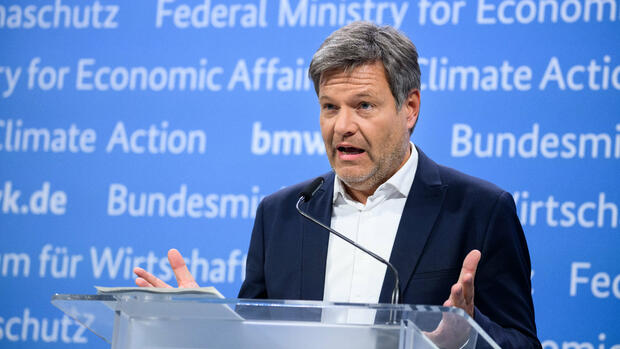With the amendment to the law, the Economics Minister largely abolishes the sector targets.
(Photo: dpa)
Berlin Economics Minister Robert Habeck (Greens) says goodbye to the rigid requirements for CO2 reduction for individual sectors with an amendment to the Climate Protection Act. In the future, the total emissions from all sectors will become the decisive reference value for climate protection. Habeck is also presenting a climate protection program that should bring Germany much closer to the climate goals for 2030. The package of climate protection law and climate protection program went to the departmental vote on Wednesday.
Habeck said that the climate package had been “intensely wrestled and negotiated” in recent weeks, and months of standstill were coming to an end.
>> Read also: The results of the coalition committee are a disenchantment with the Greens
The package follows the decisions of the coalition committee at the end of March. At that time, the traffic light coalition had decided to check compliance with the climate protection goals in the future “using a cross-sectoral and multi-year overall account”.
In the currently valid version, the climate protection law passed by the grand coalition in 2019 sets annual reduction targets for the industry, building, transport, agriculture and waste management sectors. There are no yearly specifications for the energy industry, only a target value for 2030.
Ministry: “We are switching from looking back to looking forward”
If the annual targets are exceeded in a sector, the responsible ministry must submit an immediate program within a tight deadline that is intended to help close the reduction gap. The transport and building sectors have regularly had the worst performances in recent years. In 2022, both had missed their goals.
Germany’s self-imposed climate target of reducing all greenhouse gas emissions by 65 percent by 2030 compared to 1990 is finally within reach. Federal Ministry of Economics
In the future, the annual targets per sector will become less important. Habeck said that in the future the total emissions of a year and the forecast of the future development of emissions will be “the central control parameters”. Climate protection is becoming “more forward-looking, more flexible and therefore more efficient”. In the future, the federal government will bear even greater overall responsibility for compliance with the requirements.
The annual emission quantities of the individual sectors are retained as a measurement variable. However, they are only important for monitoring and evaluating the reduction successes. A paper by the Ministry of Economic Affairs states that the changeover is to be made “from the past to the future” and that compliance with the climate protection targets will in future be checked using a “cross-sector, multi-annual accounting”.
The FDP, in particular, had pushed for a move away from rigid specifications for each individual sector because they were too inflexible. Parts of the economy had also heavily criticized the current regulation. They had warned that the current regulation promoted activism. Transport Minister Volker Wissing (FDP) had recently been heavily criticized for not having presented an immediate program. The deadline for this is July 15th.
Climate protection organizations, in turn, had sharply criticized the traffic light coalition’s plans to change the climate protection law. They insist on continuing to pursue the sector goals and making the individual ministries responsible. The traffic light coalition support the critics by saying that the amendment to the law will not emit a ton more CO2 than the previous law.
Habeck: “We close 80 percent of the climate gap”
With the climate protection program one could “probably close up to 80 percent of the climate gap that we inherited from the grand coalition,” said Habeck. According to calculations by the Ministry of Economic Affairs, 70 percent of all emissions that need to be reduced by 2030 are already covered by measures decided by the traffic light coalition.
According to the calculations, political measures have been agreed for another ten percent that still have to be implemented. “Germany’s self-imposed climate goal of reducing all greenhouse gas emissions by 65 percent by 2030 compared to 1990 levels has finally come within reach,” says a paper by the ministry.
On the one hand, the program lists measures that the traffic light coalition has already launched; These include accelerating the expansion of renewable energies and the Germany ticket. Other measures are to follow – such as the reform of the Building Energy Act or the planned CO2 surcharge for trucks. The income from the CO2 surcharge is to be used to expand the rail network.
More: Wissing shies away from fact checking when it comes to climate protection
